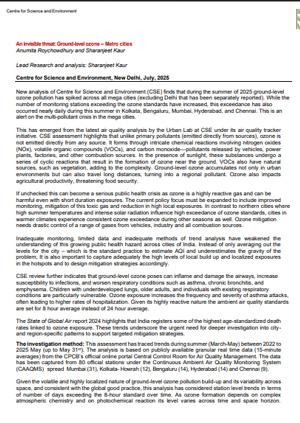An invisible threat: Ground-level ozone – Metro cities
July 16, 2025
New analysis of Centre for Science and Environment (CSE) finds that during the summer of 2025 ground-level ozone pollution has spiked across all mega cities (excluding Delhi that has been separately reported). While the number of monitoring stations exceeding the ozone standards have increased, this exceedance has also occurred nearly daily during this summer in Kolkata, Bengaluru, Mumbai, Hyderabad, and Chennai. This is an alert on the multi-pollutant crisis in the mega cities.
This has emerged from the latest air quality analysis by the Urban Lab at CSE under its air quality tracker initiative. CSE assessment highlights that unlike primary pollutants (emitted directly from sources), ozone is not emitted directly from any source. It forms through intricate chemical reactions involving nitrogen oxides (NOx), volatile organic compounds (VOCs), and carbon monoxide—pollutants released by vehicles, power plants, factories, and other combustion sources. In the presence of sunlight, these substances undergo a series of cyclic reactions that result in the formation of ozone near the ground. VOCs also have natural sources, such as vegetation, adding to the complexity. Ground-level ozone accumulates not only in urban environments but can also travel long distances, turning into a regional pollutant. Ozone also impacts agricultural productivity, threatening food security.

Share this article